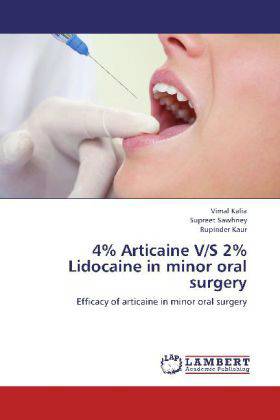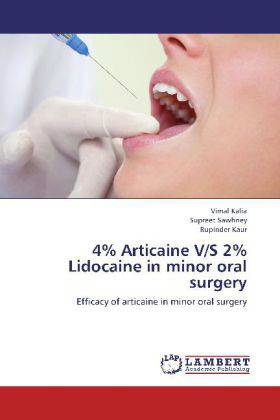
- Afhalen na 1 uur in een winkel met voorraad
- Gratis thuislevering in België vanaf € 30
- Ruim aanbod met 7 miljoen producten
- Afhalen na 1 uur in een winkel met voorraad
- Gratis thuislevering in België vanaf € 30
- Ruim aanbod met 7 miljoen producten
Zoeken
4% Articaine V/S 2% Lidocaine in minor oral surgery
Efficacy of articaine in minor oral surgery
Vimal Kalia, Supreet Sawhney, Rupinder Kaur
Paperback | Engels
€ 67,45
+ 134 punten
Omschrijving
Local anesthetics have been called "dentistry's most important drug" for pain control which is being widely used in oral surgery, affording comfort and safety for both the patient and operator when used correctly. The choice of anesthetic solution is based on few important considerations like: potency, latency, duration, pharmacokinetics and toxicity. Lidocaine synthesized by Lofgren in 1943 was the fist amide prepared. Lidocaine is most widely used for pain control because of its pharmacokinetic characteristics and low toxicity compared with other type of local anesthetics. This make it safe for use in dental practice. Articaine HC1 was synthesized by Rusching et al. in 1969 and was first marketed in Germany in 1969 with the name Carticaine. By 1983 the drug was available in all of Europe and Canada," and was approved in US in 2000 and is available as a 4% solution with epinephrin 1:100000. The present study was undertaken to compare the anesthetic efficacy of 4% articaine with epinephrine (1:1,00,000) versus 2% lidocaine with epinephrine (1:1,00,000) during minor oral surgical procedures.
Specificaties
Betrokkenen
- Auteur(s):
- Uitgeverij:
Inhoud
- Aantal bladzijden:
- 196
- Taal:
- Engels
Eigenschappen
- Productcode (EAN):
- 9783659201424
- Uitvoering:
- Paperback
- Afmetingen:
- 150 mm x 12 mm
- Gewicht:
- 278 g

Alleen bij Standaard Boekhandel
+ 134 punten op je klantenkaart van Standaard Boekhandel
Beoordelingen
We publiceren alleen reviews die voldoen aan de voorwaarden voor reviews. Bekijk onze voorwaarden voor reviews.











